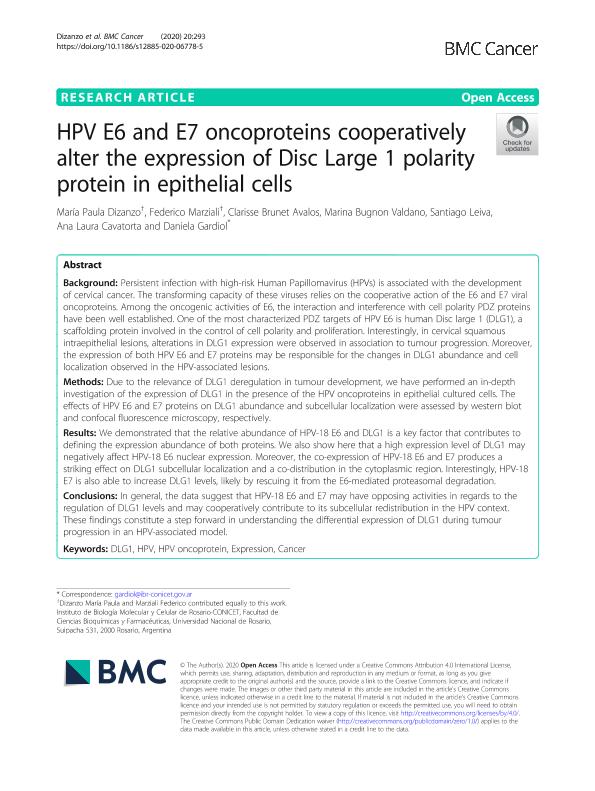Mostrar el registro sencillo del ítem
dc.contributor.author
Dizanzo, Maria Paula

dc.contributor.author
Marziali, Federico Emanuel

dc.contributor.author
Brunet Avalos, Clarisse

dc.contributor.author
Bugnon Valdano, Marina Paula

dc.contributor.author
Leiva, Santiago Gabriel

dc.contributor.author
Cavatorta, Ana Laura

dc.contributor.author
Gardiol, Daniela Nora

dc.date.available
2023-01-25T10:45:49Z
dc.date.issued
2020-04
dc.identifier.citation
Dizanzo, Maria Paula; Marziali, Federico Emanuel; Brunet Avalos, Clarisse; Bugnon Valdano, Marina Paula; Leiva, Santiago Gabriel; et al.; HPV E6 and E7 oncoproteins cooperatively alter the expression of Disc Large 1 polarity protein in epithelial cells; BioMed Central; BMC Cancer; 20; 1; 4-2020; 1-13
dc.identifier.issn
1471-2407
dc.identifier.uri
http://hdl.handle.net/11336/185488
dc.description.abstract
Background: Persistent infection with high-risk Human Papillomavirus (HPVs) is associated with the development of cervical cancer. The transforming capacity of these viruses relies on the cooperative action of the E6 and E7 viral oncoproteins. Among the oncogenic activities of E6, the interaction and interference with cell polarity PDZ proteins have been well established. One of the most characterized PDZ targets of HPV E6 is human Disc large 1 (DLG1), a scaffolding protein involved in the control of cell polarity and proliferation. Interestingly, in cervical squamous intraepithelial lesions, alterations in DLG1 expression were observed in association to tumour progression. Moreover, the expression of both HPV E6 and E7 proteins may be responsible for the changes in DLG1 abundance and cell localization observed in the HPV-associated lesions. Methods: Due to the relevance of DLG1 deregulation in tumour development, we have performed an in-depth investigation of the expression of DLG1 in the presence of the HPV oncoproteins in epithelial cultured cells. The effects of HPV E6 and E7 proteins on DLG1 abundance and subcellular localization were assessed by western blot and confocal fluorescence microscopy, respectively. Results: We demonstrated that the relative abundance of HPV-18 E6 and DLG1 is a key factor that contributes to defining the expression abundance of both proteins. We also show here that a high expression level of DLG1 may negatively affect HPV-18 E6 nuclear expression. Moreover, the co-expression of HPV-18 E6 and E7 produces a striking effect on DLG1 subcellular localization and a co-distribution in the cytoplasmic region. Interestingly, HPV-18 E7 is also able to increase DLG1 levels, likely by rescuing it from the E6-mediated proteasomal degradation. Conclusions: In general, the data suggest that HPV-18 E6 and E7 may have opposing activities in regards to the regulation of DLG1 levels and may cooperatively contribute to its subcellular redistribution in the HPV context. These findings constitute a step forward in understanding the differential expression of DLG1 during tumour progression in an HPV-associated model.
dc.format
application/pdf
dc.language.iso
eng
dc.publisher
BioMed Central

dc.rights
info:eu-repo/semantics/openAccess
dc.rights.uri
https://creativecommons.org/licenses/by/2.5/ar/
dc.subject
CANCER
dc.subject
DLG1
dc.subject
EXPRESSION
dc.subject
HPV
dc.subject
HPV ONCOPROTEIN
dc.subject.classification
Virología

dc.subject.classification
Ciencias Biológicas

dc.subject.classification
CIENCIAS NATURALES Y EXACTAS

dc.title
HPV E6 and E7 oncoproteins cooperatively alter the expression of Disc Large 1 polarity protein in epithelial cells
dc.type
info:eu-repo/semantics/article
dc.type
info:ar-repo/semantics/artículo
dc.type
info:eu-repo/semantics/publishedVersion
dc.date.updated
2021-09-06T21:04:40Z
dc.journal.volume
20
dc.journal.number
1
dc.journal.pagination
1-13
dc.journal.pais
Reino Unido

dc.journal.ciudad
Londres
dc.description.fil
Fil: Dizanzo, Maria Paula. Consejo Nacional de Investigaciones Científicas y Técnicas. Centro Científico Tecnológico Conicet - Rosario. Instituto de Biología Molecular y Celular de Rosario. Universidad Nacional de Rosario. Facultad de Ciencias Bioquímicas y Farmacéuticas. Instituto de Biología Molecular y Celular de Rosario; Argentina
dc.description.fil
Fil: Marziali, Federico Emanuel. Consejo Nacional de Investigaciones Científicas y Técnicas. Centro Científico Tecnológico Conicet - Rosario. Instituto de Biología Molecular y Celular de Rosario. Universidad Nacional de Rosario. Facultad de Ciencias Bioquímicas y Farmacéuticas. Instituto de Biología Molecular y Celular de Rosario; Argentina
dc.description.fil
Fil: Brunet Avalos, Clarisse. Consejo Nacional de Investigaciones Científicas y Técnicas. Centro Científico Tecnológico Conicet - Rosario. Instituto de Biología Molecular y Celular de Rosario. Universidad Nacional de Rosario. Facultad de Ciencias Bioquímicas y Farmacéuticas. Instituto de Biología Molecular y Celular de Rosario; Argentina
dc.description.fil
Fil: Bugnon Valdano, Marina Paula. Consejo Nacional de Investigaciones Científicas y Técnicas. Centro Científico Tecnológico Conicet - Rosario. Instituto de Biología Molecular y Celular de Rosario. Universidad Nacional de Rosario. Facultad de Ciencias Bioquímicas y Farmacéuticas. Instituto de Biología Molecular y Celular de Rosario; Argentina
dc.description.fil
Fil: Leiva, Santiago Gabriel. Consejo Nacional de Investigaciones Científicas y Técnicas. Centro Científico Tecnológico Conicet - Rosario. Instituto de Biología Molecular y Celular de Rosario. Universidad Nacional de Rosario. Facultad de Ciencias Bioquímicas y Farmacéuticas. Instituto de Biología Molecular y Celular de Rosario; Argentina
dc.description.fil
Fil: Cavatorta, Ana Laura. Consejo Nacional de Investigaciones Científicas y Técnicas. Centro Científico Tecnológico Conicet - Rosario. Instituto de Biología Molecular y Celular de Rosario. Universidad Nacional de Rosario. Facultad de Ciencias Bioquímicas y Farmacéuticas. Instituto de Biología Molecular y Celular de Rosario; Argentina
dc.description.fil
Fil: Gardiol, Daniela Nora. Consejo Nacional de Investigaciones Científicas y Técnicas. Centro Científico Tecnológico Conicet - Rosario. Instituto de Biología Molecular y Celular de Rosario. Universidad Nacional de Rosario. Facultad de Ciencias Bioquímicas y Farmacéuticas. Instituto de Biología Molecular y Celular de Rosario; Argentina
dc.journal.title
BMC Cancer

dc.relation.alternativeid
info:eu-repo/semantics/altIdentifier/url/https://bmccancer.biomedcentral.com/articles/10.1186/s12885-020-06778-5
dc.relation.alternativeid
info:eu-repo/semantics/altIdentifier/doi/http://dx.doi.org/10.1186/s12885-020-06778-5
Archivos asociados
